Q&A
At Belgian Beauty Clinic, our goal is always to answer your questions as transparently as possible. Our specialists have prepared expert answers to a number of frequently asked questions. If your specific question is not listed in the overview below, please do not hesitate to contact us. Our team of specialists is standing by to give you the answer you are looking for.
General
Indeed! If you have developed stretch marks on your lower abdomen as a result of a pregnancy or significant weight gain, there are ways to remove those. In addition to your abdominal muscles, your skin will also be treated. Your specialist will discuss the optimal strategy or treatment with you.
If your belly has become flabby or stretched out over the years, you may benefit from this surgery. It may provide a solution if you cannot wear tight clothing comfortably anymore or if you are embarrassed to swim in public. If you have any questions about the procedure, you can talk to one of our plastic surgeons for more information without any further obligation.
A mini-abdominoplasty can be performed on people who only have excess skin and/or fat in the area underneath their navel.
This means the navel does not have to be moved and the surgical scar will be smaller. During the same procedure, your abdominal muscles are tightened as well.
During diastasis surgery, your straight abdominal muscles are tightened (again). These muscles can become weaker with age or after one or more pregnancies. You feel a dimple in the centre of your abdomen. This may cause your abdomen to become flabby and look less tight. Unfortunately, this condition cannot be rectified through sports or exercise, but this procedure can help. After the procedure, your belly will once again look tight and youthful.

During the initial interview with the attending specialist, they will enquire about your general health. If necessary, you may be asked to have a blood sample taken or an electrocardiogram (EKG) made. The anaesthesiologist will review the results and determine whether it is safe to perform the procedure. You will be asked to stop smoking: Three weeks before and after the procedure. This is done to prevent problems such as necrosis (death of the skin) and scar separation. Please do not hesitate to consult your attending physician if you need help to give up smoking.
If you are on blood thinners, you must stop taking these ten days prior to your surgery. However, you should only do so after consulting your specialist!
You must begin fasting at midnight on the day before your surgery. This means no eating or drinking (not even water) or smoking.
Indeed! If you have developed stretch marks on your lower abdomen as a result of a pregnancy or significant weight gain, there are ways to remove those. Your specialist will discuss the optimal approach or treatment with you.
If your belly has become flabby and stretched out over the years, you may benefit from this surgery. It may provide a solution if you cannot wear tight clothing comfortably anymore or if you are embarrassed to swim in public. If you have any questions about the procedure, you can talk to one of our plastic surgeons for more information without any further obligation.
In layman's terms, an abdominoplasty is also known as a “tummy tuck.” The two words mean the same thing.
During the initial interview with the attending specialist, they will enquire about your general health. If necessary, you may be asked to have a blood sample taken or an electrocardiogram (EKG) made. The anaesthesiologist will review the results and determine whether it is safe to perform the procedure.
You will be asked to stop smoking: Three weeks before and after the procedure. This is done to prevent problems such as necrosis (death of the skin) and scar separation. Please do not hesitate to consult your attending physician if you need help to give up smoking.
If you are on blood thinners, you must stop taking these ten days prior to your surgery. However, you should only do so after consulting your specialist!
You must begin fasting at midnight on the day before your surgery. This means no eating or drinking (not even water) or smoking.
Yes, they are. Acne is quite hard on the skin and sometimes your skin is not able to properly repair the damage caused by pimples. Inflammation as a result of acne may result in scars and dimples that we often find unattractive. A special laser treatment can improve the situation by boosting your body's production of subcutaneous collagen. Feel free to stop by to discuss whether laser therapy is right for you.
Here are some wonderful results achieved after several sessions of the laser treatment. It is important to remember that everyone may not achieve such excellent results!
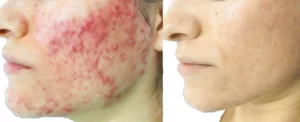
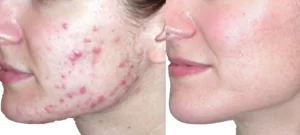
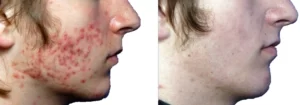
Although acne is often associated with teenagers, adults can also get pimples. Acne can be exacerbated by hormonal fluctuations, improper skin care, stress or squeezing your own pimples and blackheads.
Tip: ask us about our specialised skin care products to help prevent severe acne.
Acne occurs when the pores in your skin become blocked. Acne usually occurs in your face, but it can also occur on your neck, back and chest. When a pore becomes blocked, it causes an inflammatory reaction in your skin: the "pimple.” This pimples can have a white or black head. Sometimes, the blocked pores become so infected that they form lumps or cysts that may result in scarring.
Within two weeks, you will begin to see an improvement in the structure and colour of your skin. The final result will only be properly visible after several months. The process of rebuilding the collagen fibres beneath your skin takes time. As a result of the restructuring of the collagen, your skin will feel more supple and look smoother.
There is no need to treat normal birthmarks. However, you may decide to have a birthmark removed if you find it aesthetically unpleasant. A birthmark removal can be performed under local anaesthesia or sedation. The plastic surgeons who will perform the procedure on you at our clinic can ensure the resulting scar is as small and inconspicuous as possible.
Even newborns can have birthmarks, although most people get theirs between the ages of 3 and 20. Birthmarks are usually innocent spots, but if you have an irregularly shaped birthmark that has appeared suddenly, it is best to have it looked at by your attending physician.
Birthmarks are generally harmless. Nevertheless, you should take extra care if your birthmark:
- keeps growing
- changes colour or colour composition
- changes shape
- itches, stings or hurts
- scabs over
- bleeds
Yes. This is done because with any birthmark there is a chance - however small - that is contains malignant cells. We therefore send all birthmarks to an independent laboratory for further examination. We do not want to take any risks when it comes to your health. You will receive a separate bill from the lab itself for this examination. Your health insurance provider will cover most of the costs.
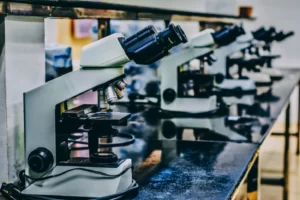
Freckles (or ephelides) are light-yellow to light-brown spots of discolouration that occur on the parts of our body that are exposed to the sun. They are most common in blonde and red-haired people. Freckles will get darker in the summer and lighter in winter. Freckles do not require any specific therapy, although you should protect them against the sun. Most people do not consider freckles to be an issue. They are common among blonde and red-haired people and are often seen as one of the seven classic hallmarks of female beauty.
A birthmark is a benign accumulation of pigment-forming cells in the skin, so-called melanocytes. Birthmarks are a natural phenomenon that everyone has. On average, a human body has around twenty-five birthmarks.
"Melanoma” is a medical term for a malignant skin tumour. A melanoma is generally larger than a normal birthmark, it has an irregular and asymmetrical shape and its pigmentation (colour) is often irregular as well. Besides brown and black, a melanoma can also be red, purple, blue, grey, white or a combination thereof. Please do not hesitate to contact a specialist if you have any doubts or concerns.
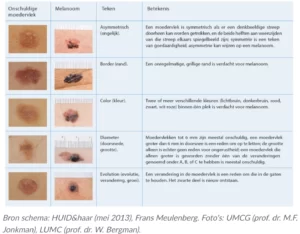
"Nevus” is simply another word for birthmark.
Floppy ears become apparent at an early age and can cause children to be bullied by their peers. Ear correction surgery is therefore performed from the age of 5 to 7. If the procedure is performed at an earlier age, the ear is not fully developed yet and there is a risk of the ear becoming misshapen as it continues to develop. It is also possible to perform this procedure on adult patients!
Yes, protruding (floppy) ears can be corrected with minor surgery. This procedure is called an otoplasty. The surgeon will reshape the cartilage of the ear until the ear has the desired shape. The resulting scar is inconspicuously hidden behind the auricle.
This procedure is often performed under local anaesthesia.
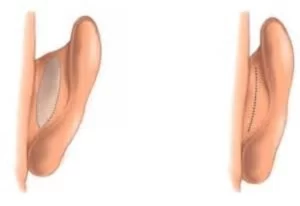
No, unfortunately there isn't. Misshapen ears are caused by a birth defect of the cartilage.
A floppy ear is often caused by a birth defect.
The cartilage that forms the auricle is insufficiently developed or misshapen. This can take many forms depending on what part of the ear is misshapen, ranging from subtly protruding ears to so-called cup ears.
There may be a degree of familial heredity to develop this condition.
Yes, there are. As with virtually all aesthetic procedures, this is a highly individual treatment. The plastic surgeon will discuss your wishes and expectations with you. Based on these criteria, we can determine what you need and give you our expert advice. For example, we may recommend a complete (major) facelift or a (mini) MACS lift. Perhaps you also want to have your eyelids corrected or a neck lift performed as part of the same surgery. In any case, your specialist will always try to achieve a natural and harmonious result, so you can live your life as carefree as possible. You will look younger, more relaxed and more well-rested!
If your wrinkles have not become too deep yet, you can slow down your skin's ageing process with injectables.
When the skin loses its elasticity, it will begin to sag, droop and become wrinkly.
This is especially visible on the forehead, around the area where your nose meets your mouth and around the mouth and jawline. Your cheeks may begin to sag, which disrupts the oval, youthful shape of your face.
The eyelids droop and make you look fatigued. The sharp cheekbones that you were always so proud of appear to be melting away, making you look old(er) in the process. If these physical changes have a negative impact on your self-image, your mood or even your social life, a facelift can help you turn back the clock. Our plastic surgeons are more than willing to give you more information and advice!
A MACS lift is also known as a mini-facelift. This is because the scar is limited to a small fold of skin near your ear. Once fully healed, the scar will be practically invisible.
By contrast, the scar of a major classical facelift can run all the way behind your ear in order to achieve the maximum effect.
MACS lift is short for: Minimal Access Cranial Suspension lift. This procedure is often combined with an eyelid correction in order to accentuate the youthful-looking results.
As their name suggests, fillers are natural products that can be used to fill in (deep) wrinkles. The skin regenerates and soften your wrinkles in a natural manner. Fillers can also be used to add extra volume to certain parts of your face, such as your lips or cheekbones. Note that the results are not permanent and the process must therefore be repeated after several months.
Fillers are commonly used to soften the nasolabial folds, marionette lines or smoker's lines, create fuller lips or subtly lift your cheekbones.
If you feel insecure about your labia and it affects your sexual life, if you have problems with your female hygiene, such as unpleasant odours or excessive moisture excretion or if you experience discomfort in your everyday life or while playing sports, you can confer with our specialists to determine if you are eligible for a labia correction.
The left and right labia are almost never of similar shape or size. One may be larger than the other. A surgical procedure can largely correct this asymmetry. Unfortunately, it is not always possible to make the labia look exactly alike, because no woman has perfectly symmetrical labia.
- You may simply be born with it.
- The shape and size of your labia may change permanently after giving birth
- Weight loss
- After the menopause, your skin may become looser
- Irritation of the labia
- Inflammation in the area around the vagina
The outer lips or labia majora are the (often) hairy skin folds on both sides of your vulva. The labia majora envelop the other parts of your vagina, such as the clitoris and the labia minora, to conceal and protect them.
The inner lips or labia minora are located in between the labia majora, on both sides of the opening into the vagina. They are not hairy and converge at the top to cover the clitoris (clitoral hood). They play an important role during sexual intercourse and may swell up as a result of sexual stimuli.
You can have sex again after six weeks.
For the first weeks after the procedure, the area around the labia will often be swollen and tight. This is quite normal. The swelling will go down within six weeks and the final result of the procedure will only be really apparent then.
In most cases, you will be able to return to work after two to three weeks.
Unfortunately, health insurance providers rarely cover this type of procedure. If you meet specific conditions, you may claim part of the costs of your breast reduction surgery. Ask your attending surgeon whether you are eligible for this compensation.
A mommy makeover consists of a combination of the following procedures. Of course, it differs per person what procedures they need. Your attending physician will discuss the available options with you:
- Breast enlargement
- Breast reduction
- Breast lift
- (Mini) abdominoplasty
- Abdominal muscle repair
- Liposuction
Although it is possible to perform a makeover as a single procedure, sometimes two or even three procedures will be required. This depends on your physical condition, your general health and your personal preferences. First and foremost, the procedure must be viable from a medical-technical perspective and your safety always comes first!
At least six months after a pregnancy and at least six months after you have stopped breastfeeding. If you were to get a mommy makeover before that time, there is a major risk of complications. The results of the procedure may also change over time and fail to meet your preconceived ideal. If you still wish to have children, it is best to postpone the procedure until after the birth of your final child.
In most cases, an inverted nipple is a harmless condition. It is often caused by having milk ducts that are too short. These milk ducts pull the nipple inward, as it were.
However, when the shape of your nipple changes suddenly and/or when only one breast is affected, it is best to have it looked at by your attending physician. In rare instances, an inverted nipple is a sign of a disease such as breast cancer.
An inverted nipple can have a number of causes:
- birth defect
- the result of hormonal changes (puberty, menopause, ...)
- the result of breastfeeding
- a sign of breast cancer (in rare cases). It is therefore important to have any sudden changes of the shape of your nipple looked at by your attending physician.
The nipple may lie flat or even point inward.
An inward pointing nipple may cause hygienic issues.
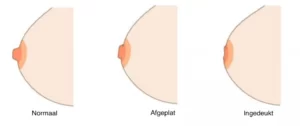
- At birth, the hairy part of your scalp contains circa 100,000 hair follicles. Blonde people have the most hair - up to 150,000 - while redheads have the least hair: 90,000.
- The average lifespan of a hair is three years.
- Every day, we shed circa 50-100 hairs from our head
- Our hair grows roughly one centimetre per month.
- The diameter of a human hair varies from 0.017 to 0.18 mm. Men's hair is twice as thick as women's hair.
Hair grows in so-called hair follicles. Each hair follicle can produce one hair after another. This process of production, growth and shedding is known as a hair cycle. Each cycle consists of three phases: anagen, catagen and telogen. The most important phases are explained below:
1. Anagen phase (active growth phase):
The root of the hair is still attached to the hair follicle. We can only destroy the hair while it is in this phase. After all, it serves as a conduit for the heat of the laser light.
2. Catagen phase (intermediate phase - transition from growth to rest):
During this phase, the process of hair growth has already stopped. This means the hair will not get any longer or darker. During this phase, the hair gradually grows upward along with the skin. This means that the root of the hair is detached from the hair follicle. As a result, the laser treatment has virtually no effect on hair in this phase.
3. Telogen phase (rest and shedding phase):
The hair is now fully detached. A new hair in the anagen phase is often found underneath the existing hair. The hair falls out at the end of this final phase. By that time, the new hair has already been formed in the follicle and the cycle begins anew.
Unfortunately, only (certain types of) darker spots can be treated. Hypopigmentation or “white” spots cannot be remedied.
After the treatment, the existing spots will be largely or entirely gone.
However, exposure to sunlight and UV radiation may cause new spots to form. It is therefore important to always protect your skin.
Repeating the treatment every now and then helps to keep your skin free of age spots.
Indeed! Most spots on the leg are the result of an accumulation of iron (so-called haemosiderin) caused by poor circulation. These pigmentation spots can often be successfully removed with the laser treatment.
Of course! In fact, age spots on your hands are an excellent indication to start a treatment. Your hands often "betray” your true age. By removing the spots with laser light, your hands will look younger and your skin smoother.
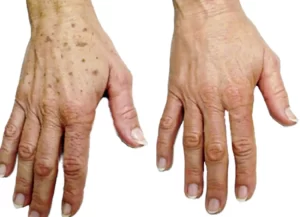
Unfortunately not, but there is one important rule you can keep in mind: always protect yourself against exposure to direct sunlight and UV radiation. Wear a hat, sunblock with a high SPF and sunglasses and stay away from tanning beds as much as possible.
Liver spots are basically a symptom of age spots or sun spots. They are practically the same thing and are easily treatable with the laser. Feel free to visit us for more information about the laser treatment.
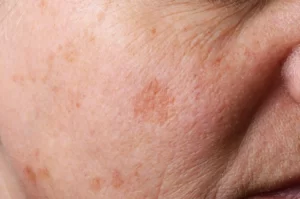
Both before and after the laser therapy, you should avoid exposing the treated area to direct sunlight for four to six weeks.
For at least two weeks before and after the treatment, you should also avoid using any tanning creams, peelings or exfoliating creams.
On the day of your treatment, do not apply any day cream or camouflage cream on the area to be treated. These creams inhibit the passage of the laser beams, thereby compromising the efficacy of the treatment.
The results will become apparent after several days. Some spots will flake off after a period of 3-7 days, while other spots will gradually become lighter and merge with the surrounding skin.
The prognosis of a PRP treatment is very good for most men and women: positive results are achieved with 70-90% of all performed treatments. The achieved results depend on e.g. your suitability for a treatment and how well you follow the recommendations that may affect the final outcome. Of course, no two situations are the same and the results of a PRP treatment will vary from person to person.
This treatment has been around for several years and it is commonly used to treat hair loss. The technique has been well researched and has few downsides. It is relatively cheap and offers long-term results. Patients with thinning hair, fragile hair and early-onset baldness are all eligible for this treatment.

The acronym PRP stands for “Platelet Rich Plasma.” This plasma is entirely natural and therefore very safe.
After the treatment, the existing blood vessels and redness will be largely or entirely gone.
However, new blood vessels may form over time. Unfortunately, there is (currently) no way to prevent this. If your body has an underlying vascular issue, you may require additional treatments.
Depending on the severity of your rosacea, you may require two to three sessions. In many cases, sufficient results are achieved after only a single treatment, which means no subsequent treatment is needed or desired.
Unfortunately not, although there are a few basic rules to remember:
- avoid drinking alcohol as much as possible
- avoid eating spicy herbs as much as possible
- avoid sudden temperature changes or heat (bath, sauna, ...)
- protect yourself against the sun (wear a hat, use sunblock, ...)
- clean your face using a mild cleaning product and lukewarm water
- pat - do not rub - your skin dry, ideally with a cotton cloth
- moisturise your skin with liquid creams; avoid overly greasy products
- avoid products that irritate the skin, such as those containing alcohol
- avoid peelings and emulsions that contain fruit acids. These will only further irritate your skin and exacerbate the redness.
Both before and after the laser therapy, you should avoid exposing the treated area to direct sunlight for four to six weeks. For at least two weeks before and after the treatment, you should also avoid using any tanning creams.
Most patients will begin to see significant improvements two to six weeks after their treatment. However, your final result may only be visible after several months and after several laser treatments.
Certainly! If laser therapy proves ineffective, we can offer alternative treatment options as well. These range from special scar cream and/or patches to LED therapy and plastic surgery procedures. Contact us for more information about these treatment options.
Generally speaking, most scars can either be corrected or have their appearance significantly improved. The desired result can sometimes be achieved with a single treatment, although multiple treatments are usually needed. It all depends on the position, depth and size of the scar. We use extremely powerful lasers to make your scar as inconspicuous as possible. Our specialists can advise you on what will work best for you. They have made a career out of performing surgery on people with minimal scarring.
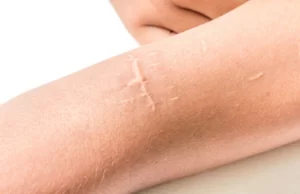
This type of scar can also be significantly improved. We use several powerful lasers to soften these dimples. If your scars are already too deep, we can offer a number of alternative treatments, such as peelings.
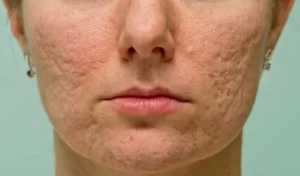
If your wrinkles have not become too deep yet, you can slow down your skin's ageing process with injectables.
A thread lift is a treatment that uses soluble thread. Once the threads have dissolved, the skin may begin to sag once more. Many patients therefore require a follow-up treatment after one to two years. If you are looking for a more permanent solution, you can find more information in the "Facelift” chapter.
When the skin loses its elasticity, it will begin to sag, droop and become wrinkly.
This is especially visible on the forehead, around the area where your nose meets your mouth and around the mouth and jawline. Your cheeks may begin to sag, which disrupts the oval, youthful shape of your face. The eyelids droop and make you look fatigued. The sharp cheekbones that you were always so proud of appear to be melting away, making you look old(er) in the process.
If these physical changes have a negative impact on your self-image, your mood or even your social life, a thread lift can help you turn back the clock.
This is the ideal treatment for:
- Young patients who are showing the first signs of ageing around their face as their skin becomes looser
- Patients who have already undergone a facelift and want to restore their face to its former youthful glory without another invasive procedure
- Patients who want to avoid a lengthy surgical procedure and would instead prefer a treatment that is given under local anaesthesia
Our plastic surgeons are more than willing to give you more information and advice!
The specialist uses small soluble threads to pull your skin taut again. The threads feature small hooks that attach to and tighten your tissue. We use threads with a 360° working radius to achieve an optimal effect.
A thread lift is also known as a lunchtime facelift. This is because the procedure can be performed under local anaesthesia. You do not have to be put under and there is no need to cut into your skin. All it takes is a small puncture to allow the thread to pass through your skin. Once fully healed, the scar will be practically invisible. You do not need to bring someone with you and you can go home immediately after your treatment.
As with virtually all aesthetic procedures, this is a highly individual treatment. The plastic surgeon will discuss your wishes and expectations with you. Based on these criteria, we can determine what you need and give you our expert advice.
In any case, your specialist will always try to achieve a natural and harmonious result, so you can live your life as carefree as possible. You will look younger, more relaxed and more well-rested!
Our specialist will go over the available options with you.
In many cases, the physician will perform or have performed an examination before injecting Botox. This is done to determine the cause of your vaginismus.
Experience shows that not all women with vaginismus are eligible for a Botox treatment. For example, a Botox injection would be practically useless if you have an extremely tight vagina or if you suffer from a muscle disease.
Furthermore, the success rate (70%) is slightly lower for women who have never been able to have sexual intercourse (primary vaginismus). The best results (>95% success) are achieved with women who were previously able to have sexual intercourse without any difficulty (secondary vaginismus).
The treatment is only useful if you will have sexual intercourse afterwards. If you do not have sexual intercourse after the Botox treatment, the problems will recur after three to six months.
The relaxing effect can be felt after just a few days and will persist for up to six months. The results will go away entirely after a while, yet having a normal sex life during this period may spontaneously heal your vaginismus.
On average, women need two follow-up treatments to fully get rid of their vaginal tightness. In extremely rare cases, the treatment must be repeated indefinitely (every six months).
If you are insecure about your vagina, if you experience discomfort during sexual intercourse or if you have problems with your female hygiene, such as unpleasant odours or excessive moisture excretion, you can confer with our specialists to determine what treatment is best for you.
- You may simply be born with it.
- Your vagina may change permanently after giving birth
- Weight loss
- Constipation
- After your menopause, the vaginal wall may become looser and dryer
- Long-term irritation
- Inflammation in the area around the vagina
You can have sex again after six weeks.
For the first weeks after the procedure, the area will often be swollen and tight. This is quite normal. The swelling will gradually go down within the first six weeks. You will be able to see and feel the final results of the procedure after six to twelve months.
Surgery
Yes. Due to the fact that this is a fairly major procedure, it cannot be performed safely under local anaesthesia. Our anaesthesiologist will therefore put you to sleep. You have nothing to worry about. You will be monitored closely throughout the entire procedure. You can rest easy knowing you are in the safe hands of our highly experienced team of anaesthesiologists.
If possible, you can also choose to be sedated instead. It is best to discuss this option with your attending physician beforehand.
To perform abdominal muscle repair surgery, an incision will be made at the bottom of your abdomen. The location of the incision will be chosen to ensure it is hidden by your bikini line. Once the scar has fully healed after twelve to eighteen months, it will be hard to tell you ever had surgery at all.
You can consult your plastic surgeon for more information about proper aftercare for your scar.
No. If you only want your abdominal muscles tightened and do not need a skin correction, there is no need to detach your navel.
If you do want a skin correction to deal with sagging skin or panniculus, your navel will be moved. The scar will be hidden as inconspicuously as possible inside the navel itself.
No, this is only done if the abdominal muscles have become slack. This often happens after several pregnancies. Your abdomen may begin to bulge as a result. After tightening the inner abdominal muscles, this problem will be alleviated.
Yes. Due to the fact that this is a fairly major procedure, it cannot be performed safely under local anaesthesia. Our anaesthesiologist will therefore put you to sleep. You have nothing to worry about. You will be monitored closely throughout the entire procedure. You can rest easy knowing you are in the safe hands of our highly experienced team of anaesthesiologists.
If possible, you can also choose to be sedated instead. It is best to discuss this option with your attending physician beforehand.
Sometimes. If you only have a bit of sagging skin or excess fat underneath your navel, there is no need to detach it. However, if you have excessive sagging skin or severe panniculus that covers your entire abdomen, your navel will be moved. The scar will be hidden as inconspicuously as possible inside the navel itself.
The laser kills bacteria that cause inflammation in the skin. It also heats up the sebum in the sebaceous glands, making it more fluid and less likely to block the pores of your skin. As an added effect of the laser treatment, the skin will immediately react to the heat by producing new connective tissue (collagen). This will make your acne scars less visible.
Depending on the severity of your acne, you will need to be treated every two to three weeks for a total of five to eight treatments.
Afterwards, it is enough to have a follow-up treatment every three to four months. This ensures the results stay optimal.
A treatment with an injectable is often administered during the consultation itself. Your physician will discuss what wrinkles or characteristics are unattractive and they listen to your wishes.
The specialist will then carefully analyse your skin to determine what areas can be optimised and what products are best for you. Our goal is always to achieve a natural-looking result and highlight your personal appearance.
In most cases, subcutaneous sutures will be used. The plastic surgeon will make your scar as small and inconspicuous as possible. Your specialist can give you more information about your specific case.
Our plastic surgeons are experts at making scars as small and inconspicuous as possible. After all, that is what they do for a living! They use special techniques to camouflage and hide the incision as effectively as possible. If the healing process (which takes 12-18 weeks) proceeds without complications, you can expect to have a practically invisible scar afterwards. If the scar is still too visible, you can come back for a correction. This may consist of special scar creams or patches, laser therapy or a minor follow-up procedure.
No, only a procedure with implanted prostheses will guarantee a safe and lasting result. Hormones and vitamins will only have a limited impact on the volume of your breasts. The improper use of hormones can even be detrimental to your health!
Most likely, yes. A breast enlargement usually does not affect your ability to breastfeed, provided that the mammary gland and milk ducts were not damaged during the procedure. Fortunately, this only happens in very rare instances.
The surgeon will discuss the most suitable type of incision with you. The method of gaining access via the crease of your breast is most common. This is a safe technique by which to implant the prostheses symmetrically without damaging the mammary glands. In the future, you will easily be able to breastfeed if you should so desire. The resulting scar will usually heal without complications and become all but invisible. After one year, all that is left will be a thin, skin-coloured line.
No, in most cases it will not. As a result of the pressure of the prosthesis on the nerve, the sensitivity of your nipple may be affected. It may become more or less sensitive. This effect is usually temporary and the sensitivity of your nipple will gradually normalise after several weeks.
Most likely, yes. A breast lift (with or without enlargement) usually does not affect your ability to breastfeed, provided that the mammary gland and milk ducts were not damaged during the procedure. Fortunately, this only happens in very rare instances.
There are myriad wonderful and informative videos to be found online. This video from an Australian colleague nicely summarises the technique that we use.
There are several ways to perform a breast lift, depending on the amount of excess skin you have and how much the breast needs to be lifted. The surgeon will discuss the most suitable type of incision with you.
- A minimal breast lift will produce a small scar near your nipple. You will either have a partial (“crescent”) or full (“donut") scar.
- For a standard mastopexy, you will also have a vertical downward scar. This is known as a lollipop scar, because the scar ends up looking much like a lollipop.
- For a major breast lift, there will also be an incision made in the crease of your breast (“anchor” or “inverted T"). Fortunately, this scar is hardly visible as it is located underneath your breast.
The scar will be red and visible at first, but it will usually heal without complications and become all but invisible. After one year, all that is left will be a thin, skin-coloured line.
No, we will not place any drainage tubes. In rare cases, a drain will have to be placed to get rid of excess fluids. This drain can usually be removed the next day.
No, in most cases it will not. As a result of the incision and the relocation of the nipple, but also as a result of the pressure of the prosthesis on the nerve, the sensitivity of your nipple may be affected. It may become more or less sensitive. This effect is usually temporary and the sensitivity of your nipple will gradually normalise after several weeks.
Depending on your individual situation: one to two hours. You can leave the clinic that same day. The procedure is always performed in our day clinic.
Although everyone experiences pain differently, the use of local anaesthesia and sufficient pain medication generally make the procedure easily bearable.
However, if the prospect of undergoing the procedure causes you too much anxiety, you can be sedated or put under general anaesthesia instead.
The incision is made behind the ear. The scar is therefore well hidden and practically invisible once it heals.
No, this procedure is generally performed under local anaesthesia, which most patients find perfectly bearable. However, if this makes you anxious, you can opt for sedation or general anaesthesia instead.
Young children (up to the age of 15) are always put under, because this is less stressful for the patient at their age.
The doctor uses a diathermy device to make an incision with a small electric blade. The benefit of this approach is that the small blood vessels are immediately cauterised. The same result is achieved when using a laser.
During an eyelid correction, a part of the skin and usually a bit of muscle are removed. If necessary, some fat will also be removed from the corner of your eye. There are also other procedures that can be performed at the same time as an eyelid correction. For example, it is possible to remove a piece of the frown muscle via the same incision, which alleviates frown lines.
The scars will be positioned in the fold of the upper eyelid, making them invisible when your eyes are open. For a lower eyelid correction, it is sometimes possible to perform the procedure via the back of the eyelid. In that case, there will be no visible scarring at all. If this procedure is instead performed via the front of the eyelid, the scar will be located right below your eyelashes. After just a few weeks, the scar will be hardly visible at all.
Sometimes, it is necessary to make the scar slightly longer (in the crow's feet). This means the scar will remain visible a bit longer as well, although you can easily conceal it with make-up.
In most cases, the wounds will be closed using an extremely thin suture. The thread can be removed painlessly after five to seven days. Although it is possible to use wound tape instead, there are more risks involved in doing so.
The procedure is performed in our day clinic and will take circa one hour. You may leave the clinic several hours after your procedure.
During a labia reduction, we remove excess skin from the labia to give them a more harmonious shape. There are two commonly used techniques:
- To perform a wedge resection, the surgeon will remove a triangular piece of excess tissue from your labia. This technique is often used when the amount of excess tissue is small or localised.
- To perform a trim excision - also known as an edge resection - the surgeon will remove tissue across the entire length of the labia. This technique is only used if there is a large amount of excess tissue on the labia or in cases of hyperpigmentation (dark discolouration) on the edges of the labia.
What technique is used depends on the patient's wishes and her specific anatomy.
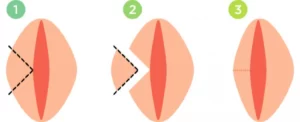
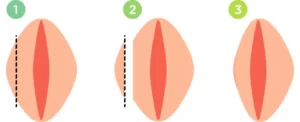
For the vast majority of women, it is possible to perform the procedure under local anaesthesia. The benefit of this is that you are not put under and can go home sooner.
However, if you feel anxious about your procedure, you can opt to be sedated instead. You will be unconscious for the entire duration and can undergo the treatment without any stress. This is also done in our day clinic.
An inverted nipple is often the result of the milk ducts being too short and pulling the nipple inward. By detaching the milk ducts from the nipple, it can regain its original shape.
Note that there is a chance you may not be able to breastfeed anymore after undergoing this treatment. It is therefore advisable to only have this treatment performed if you do not want to have any (more) children.
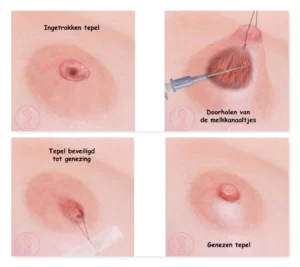
No two nose corrections are the same. After all, people have different wishes. You can therefore talk to our specialists about your preferences. They will explain the available options to you and draw up a plan for your procedure. Every case is individually assessed to offer you optimal advice.
This depends on what needs to be done, but the average procedure takes two to three hours. The procedure can be performed under local or general anaesthesia. This depends on the extensiveness of the surgery. Talk to your plastic surgeon to discuss the possibilities.
During nose correction surgery, it is possible to have one or more of the following corrections performed:
- making the nose smaller
- refining the tip of the nose
- making the nostrils narrower
- straightening the nose
- removing a hump on the nose
- alleviating respiratory difficulties
No two nose corrections are the same. You can therefore talk to our specialists about your wishes. They will explain the available options to you and offer you clear advice.
There are two ways to perform an aesthetic nose correction. The nose correction can be performed via an incision inside the nose (closed nose correction) or via an incision underneath the nose (open nose correction).
During a closed nose correction, no external incisions are made. As a result, the recovery period is shorter and the procedure is less invasive. However, the possibilities for reshaping the tip of the nose are limited for this type of nose correction. The scar will be invisible. During an open nose correction, an incision is made on the underside of the columella, i.e. the soft tissue between your nostrils. This provides a better view of the cartilage structure of the nose, allowing the surgeon to reshape the tip of the nose far more accurately.
After an open nose correction, the nose will remain swollen a bit longer, as the lymph drainage is disrupted more. The scar is barely visible and will all but disappear in matter of weeks.
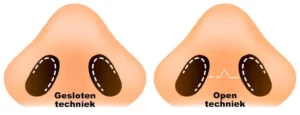
A hair and its root grow out of a hair follicle. The hair follicle stimulates the hair's growth and only by destroying the follicle can we permanently prevent hair growth. The hairs guide the laser light into the hair follicles, which are then permanently destroyed by the heat of the laser.
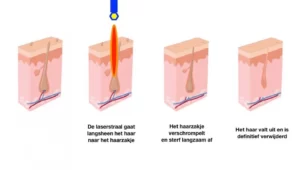
This is because hairs go through a number of phases as they grow. Destroying the hair follicles permanently stops hair growth. Only those hairs that are in their active growth phase can be destroyed by the laser, because they are only connected to the hair follicles during this phase.
The laser treatment itself takes fifteen to thirty minutes per session, depending on the number and size of the spots being treated.
Superficial pigmentation spots will generally require one or two treatments to remove. Deeper pigmentation spots will only disappear after several follow-up treatments.
Unfortunately, it is impossible to guarantee that every patient’s pigmentation spots will disappear entirely. Some darker spots are slow to react to the treatment or may only disappear partially or not at all, not even after multiple follow-up treatments. It is therefore important to avoid the factors that stimulate the recurrence of pigmentation (such as exposure to sunlight and UV radiation), even if the spots initially went away.
You may experience a slight stinging or burning sensation during the treatment. It feels like a small rubber band hitting your skin or like a brief pin prick. Virtually all patients find this sensation perfectly bearable, however.
After the treatment, you will experience hardly any pain in the area. If a larger area was treated, the afterpain will feel like a mild sunburn that may persist for several hours.
Generally, a PRP treatment will take no more than sixty minutes. You may leave the clinic shortly after your treatment and resume your daily activities (in conference with your attending specialist).
Most people do not experience much pain during this treatment. It is necessary to stick a needle in your skin to extract blood and inject the PRP, but this does not bother most people.
- improve the blood flow in the hair follicles
- stimulate the growth of the hair follicles
- make the hair follicles healthy and strong
- reduce inflammation
result in thicker and stronger hairs
The laser treatment itself takes fewer than thirty minutes per session.
You may experience a slight stinging or burning sensation during the treatment. Virtually all patients find this sensation perfectly bearable, however.
After the treatment, you will experience no or hardly any pain in the area. There is therefore no need to take pain medication.
In most cases, subcutaneous sutures will be used. The plastic surgeon will make your scar as small and inconspicuous as possible. Your specialist can give you more information about your specific case.
Certainly! If you do not want to undergo a surgical procedure, we can offer alternative treatment options as well. These range from special scar creams and/or patches to LED therapy and laser treatments. Contact us for more information about these treatment options.
Our plastic surgeons are experts at making scars as small and inconspicuous as possible. After all, that is what they do for a living! They use special techniques to camouflage and hide the incision as effectively as possible. If the healing process (which takes 12-18 weeks) proceeds without complications, you can expect to have a practically invisible scar afterwards. If the scar is still too visible, you can come back for a second correction. This may consist of special scar creams or patches, laser therapy or a minor follow-up procedure.
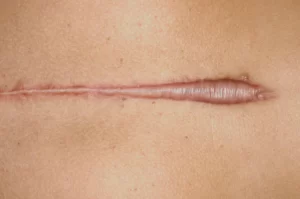
Yes, there are. There are many different types of threads of varying quality available on the market. For that reason, it is important to ensure you are well informed. In our clinic, we only use products that meet the highest possible safety standards. We use threads with a helix structure. This gives them a 360° action range and allows them to optimally tighten the skin.
Depending on the number of threads, the procedure will take twenty to thirty minutes. This explains why a thread lift is sometimes called a "lunchtime facelift.” Despite its short duration, it achieves an optimal effect!
That very much depends on your personal situation. If you have severe sagging skin, that will naturally require more threads than if your skin still looks relatively young.
Not at all!
The specialist will begin by numbing the treatable area with local anaesthesia. This means you will not or hardly feel the procedure. You will remain conscious throughout the entire procedure and can go home immediately afterwards. At home, you can take a mild painkiller to prevent any pain you may feel when you wake up in the morning.
Beautox (Botulinum toxin A) is a compound that can temporarily weaken/paralyse muscles very accurately. It is injected directly into the muscles in question. The use of Beautox temporarily weakens the muscles, thereby relaxing your pelvic floor and making sexual intercourse possible again.
Under local anaesthesia, the procedure will take circa forty-five minutes. You may leave the clinic shortly afterwards. Under sedation, the procedure will take circa ninety minutes and be performed in our day clinic. You may leave the clinic several hours after your procedure.
This treatment is performed by inserting a small tube in the vagina. This means there will be no visible scarring. With the help of local anaesthesia, the procedure is virtually painless. As an added benefit, there is no need to put you under general anaesthesia. The treatment has a very short recovery time and is exceptionally effective. You will begin to notice the difference even after the first treatment.
The procedure is performed via the opening of your vagina. As a result, there will be no visible scarring. The specialist will discuss the available surgical techniques with you. If there is only moderate slackness, it may be sufficient to inject your body's own fat into the vaginal wall (lipofilling). This will restore its former tightness.
If there is too much slackness, some skin and underlying tissue will be removed from the rear of the vagina, thereby narrowing the vaginal opening. The weakened pelvic floor muscles will be reattached using soluble sutures. Everything is put back in its original position and the muscles are strengthened.
The end result will be a vagina that feels tighter.
The laser treatment will take circa thirty minutes. You may leave the clinic shortly afterwards.
The surgical procedure is performed in our day clinic and will take circa ninety minutes. You may leave the clinic several hours after your procedure.
There are two commonly used techniques:
- Laser
- Surgery
What technique is used depends on the patient's wishes and her specific anatomy.
The laser treatment can be performed under local anaesthesia. The benefit of this is that you are not put under and can go home sooner.
You will be sedated during the actual surgery. This means you will be unconscious for the entire duration of the procedure and can undergo the treatment without any stress. This is also done in our day clinic.
Aftercare
You may experience pain during the first few days after the procedure. Although everyone experiences pain differently, the vast majority of patients only reports a stiff or tight feeling in the area (like after an intense workout) for several days after their treatment.
The pain can easily be managed with the basic pain medication prescribed by your attending surgeon. If necessary, you can take the stronger, morphine-based pain medication. This is guaranteed to alleviate your pain.
We also recommend taking it easy for a few days and giving your body a chance to recover. You must wait at least eight weeks before you start working out or doing abdominal exercises again. This is done to avoid complications.
The pain after an abdominoplasty is usually not that bad. If you combine this procedure with abdominal muscle repair surgery, you will feel more pain because the muscles are more sensitive. It will feel like you pushed yourself too hard during your workout: a stiff, tight or burning sensation.
The pain can easily be managed with the basic pain medication prescribed by your attending surgeon. If necessary, you can take the stronger, morphine-based pain medication. This is guaranteed to alleviate your pain.
We also recommend taking it easy for a few days and giving your body a chance to recover. To avoid complications, you must wait at least eight weeks before you start working out or doing abdominal exercises again.
We recommend not working out for several hours after the treatment. Instead, it is best to lie flat or massage the area.
Several weeks after your initial treatment, we will invite you back for a follow-up and to view the results. If there are still visible wrinkles two weeks after your Beautox treatment, these can be softened further with a subsequent "touch-up” treatment.
Depending on where the birthmark was removed, the healing process may take five to fourteen days. The face is the quickest to heal, while the back and joints take the longest.
Once your wounds have fully healed, you may once again use a tanning bed. Remember to cover your scars well, either with a patch or by applying sunblock with a sufficiently high SPF (50+).
No! If you are happy with the shape and size of your breasts, there is no need to replace your prostheses. However, it is advisable to regularly have an ultrasound performed to make sure everything is in order. If no problems are found, silicone prostheses can be kept for many more years.
Once the threads are in place, it is important to keep the scar dry and clean. It is best to leave the bandage on. Afterwards, you can gently apply a moisturising cream or special scar ointment on the scar twice daily. This will ensure the scar feels less hard and obtains a paler colour. In time, you will be left with an inconspicuous, thin line.
Depending on your job, you can go back to work after five days to two weeks. Remember to take enough time to rest and recover.
The surgical wounds should be kept dry and clean. If a wound gets wet, this can result in a severe infection. To avoid this, you are advised not to take showers or baths during your recovery period. You can of course use a wash cloth to freshen up, provided that you stay away from the treated area.
You may experience pain during the first few days after the procedure. Although everyone experiences pain differently, the vast majority of women only reports a stiff or tight feeling in the area for several days after their treatment.
The pain can easily be managed with the basic pain medication prescribed by your attending surgeon. If necessary, you can take the stronger, morphine-based pain medication. This is guaranteed to alleviate your pain.
You can also cool your breasts with ice to reduce swelling and tightness. Remember to protect your skin by wrapping the ice in a dish towel to avoid direct contact with your skin.
We also recommend taking it easy for a few days and giving your body a chance to recover.
Following the procedure, a (pressure) bandage will be applied for five days.
For children, we recommend wearing a hair band for one month. This will protect the ears against trauma while playing and sleeping. For the first two weeks, the hair band should be worn day and night; afterwards, it only has to be worn at night.
Adult patients are not required to wear any additional bandages. It is important to be careful, however! We therefore advise against all athletic activities for a period of four to six weeks.
You can generally resume your social activities after one week.
On the day after your surgery, you may (carefully) shower again. The patches will stay on and must be patted dry after your shower. You must wait at least six weeks before taking a bath or visiting a sauna.
A scar cream (silicone ointment) has been available for a number of years now that is proven to be effective at improving the scar and speeding up the ripening process. You will receive a prescription for this cream. It is important to avoid exposing the scar to ultraviolet light (from sunlight or a tanning bed) while the scar is red. You can protect the scar with a patch or, at a later stage, with sunblock (SPF 50).
Soon. If your upper eyelids were treated, you can go back to work after one week. If your lower eyelids were treated, you can go back to work after one or two weeks. Your eyes may be blue and swollen, but you can see perfectly well, so performing e.g. computer-based work will not be a problem. You can temporarily wear sunglasses if you want to go back to work. Remember to avoid physical exertion for the first few weeks after your procedure.
For most people, a single procedure is enough. Depending on your lifestyle (heavy exposure to sunlight, smoking, lack of sleep, etcetera), you may begin to develop excess skin over time. This can easily be corrected with a similar procedure and scar as before.
For the first week after your labia correction, you may have difficulty sitting comfortably and urinating may be painful. At home, you can cool the treated area with a cold pack. This will help alleviate the pain and swelling. In most cases, the light pain medication that the surgeon will prescribe is sufficient to reduce your discomfort.
It is important to employ proper hygienic measures! For example, you will have to carefully disinfect the wounds every day and especially after going to the bathroom.
You may experience some bleeding after your labia correction. This is no cause for concern. The best thing to do is to place a rolled-up towel between your legs and sit like that for a little while. The bleeding will stop on its own. If the bleeding does not stop or if your labia becomes severely swollen, you should contact your attending surgeon.
After the procedure, you will receive a letter with instructions. Read these instructions carefully. If you have any questions, you can contact us 24/7.
After the procedure, you will receive a prescription for one or more types of medication:
- medication to reduce the swelling of the nasal mucous membrane
- pain medication
- nasal spray to flush out your nose
- nasal cream
- sometimes antibiotics
You may sometimes experience a numb feeling in your nose, upper lip and upper incisors. This feeling will disappear after several weeks or months.
The scar of a closed nose correction will be hidden inside the nose. It will therefore not be visible. During an open nose correction, an incision is made on the underside of the columella, which is the soft tissue between your nostrils. This scar usually heals very well and will become less visible after just a few weeks. In time, it will become practically invisible.
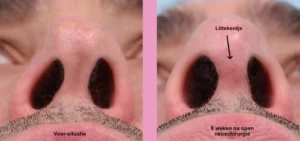
After the surgery, there may be severe swelling in the area of and around the nose, such as the eyelids. The swollen area may also have a blue-purplish colour, but that will disappear after just a few days. The swelling of the nose itself may persist for up to several months. Only once the swelling goes down will the final result of the procedure be visible.
- After the procedure, a splint is (usually) placed across your nose. This will protect your nose during the post-operative recovery period. You must leave this splint in place until your first check-up appointment.
- After the procedure, tampons are (usually) placed inside your nose. These will be removed several days after the procedure, in conference with the plastic surgeon. This means you will not be able to breathe through your nose at first. As you will be forced to breathe through your mouth, you may experience chapped lips, a dry mouth and a dry throat. Drinking regularly and moisturising your lips and mouth can alleviate these discomforts.
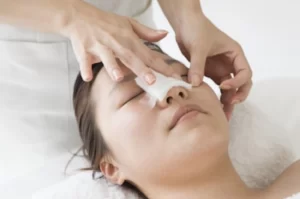
- You must not blow your nose. This is done to prevent pressure in and on your nose as much as possible. That, in turn, will prevent bleeding.
- Likewise, bending over, lifting heavy objects and physical exertion will put too much pressure on your head. It is therefore advisable to avoid these things for the first week after your procedure.
- We advise against drinking any hot soups and/or beverages on the day of the procedure. Doing so will increase the risk of bleeding. Of course, it is possible to eat and drink these things after they have cooled off.
- For an optimal healing process, we advise against smoking during the three weeks before and after your procedure. If you find it hard to give up smoking, you can contact your attending physician for advice.
- Depending on the type of surgery that was performed, you must refrain from physical exercise for several weeks. Your surgeon will go over this with you in greater detail.
- Sometimes, you will be asked to flush out your nose after the surgery. You will receive written instructions on how to do that correctly. For an optimal healing process, it is important to follow these instructions carefully.
If you follow these aftercare instructions, the risk of complications is very low. If a problem does arise or if you have any questions, please do not hesitate to contact us. We are available by phone 24/7.
After the treatment, your skin may be red and swollen. This will usually go away after a few hours. You can alleviate the swelling with a cold compress or a special cooling cream.
If large parts of your face were treated, it is advisable to elevate your head when you go to sleep on the first night in order to reduce swelling (e.g. by using several pillows).
The treated area may change colour: it may become slightly darker or lighter. This is a good sign, as it indicates that the pigment properly absorbed the laser's energy.
Your skin may also form dark superficial flakes that will fall off after three to seven days. These flakes can sometimes be quite itchy. If that is the case, it is important not to scratch at the affected area! Instead, it is best to apply a cooling cream or ointment.
In rare instances, the treated skin may develop small blisters that contain clear liquid. These blisters will dry up and scab over eventually. It is best not to puncture them in the meantime.
Avoid swimming pools, saunas, baths and (contact) sports while your skin is still flaky. You can take showers, but remember to pat (not rub) the treated area dry with a soft cotton towel.
The skin will be vulnerable after the treatment and must therefore be treated with care. If you do wish to moisturise or camouflage the treated area, ask about our special skin care products that are specifically designed for use on sensitive skin after laser treatment.
It is also important to protect your skin against exposure to sunlight and UV radiation for six weeks.
Tip: you can also return to our clinic for an intensive facial treatment that is specifically tailored to the laser treatment. Your skin will be professionally cleansed, cared for and gently moisturised with special products.
You may leave the clinic immediately after your treatment. The treated areas of your scalp may be slightly swollen and tender. Both the tenderness and any swelling will go away within 48-72 hours after your treatment.
Given that this is a “natural” healing process, it will take some time before you start to see any results. Generally speaking, most patients will begin to see minor improvements after six weeks and significant improvements after three to six months.
After the treatment, your skin may be swollen. You can alleviate the swelling with a cooling compress and special creams. It is also important to properly moisturise the skin and protect it against exposure to bright sunlight for several weeks.
- Avoid intense physical exertion and excessive exercise
- For a period of one week, avoid major temperature changes such as saunas and (bubble) baths
- Avoid drinking alcohol as much as possible during the first week
Tip: you can also return to our clinic for an intensive facial treatment that is specifically tailored to the laser treatment. Your skin will be fully cleansed, cared for and moisturised with special products.
Depending on where the treated area is located, the healing process may take five to fourteen days. The face is the quickest to heal, while the back and joints take the longest.
After the treatment, your surgeon will give you specific instructions on how to care for your wound. You will have to treat the scar with (scar) ointment and protect it from exposure to bright sunlight. To block harmful UV radiation, you can apply a sunblock with SPF 50. Keep doing this for twelve to eighteen months to achieve an optimal result.
For the first week after your vaginoplasty, you may have difficulty sitting comfortably and urinating may be painful. In most cases, the light pain medication that the surgeon will prescribe is sufficient to reduce your discomfort.
It is important to employ proper hygienic measures! For example, you will have to carefully disinfect the vagina every day and especially after going to the bathroom.
You may experience some bleeding or mucous secretion after your vaginoplasty. This is no cause for concern. The bleeding will stop on its own. If the bleeding does not stop or if it gets worse, you should contact your attending surgeon.
After the procedure, you will receive a letter with instructions. Read these instructions carefully. If you have any questions, you can contact us 24/7.
Given that this is a “natural” healing process, it will take some time before you start to see any results. Generally speaking, most patients will begin to see minor improvements after six weeks and significant improvements after three to six months.
Risks
As with any medical treatment, there are several risks associated with an abdominal muscle repair surgery. Luckily, these complications are exceedingly rare as a result of the excellent care provided by our experienced surgeons. The most common issues are:
- Infection
- Bleeding
- Asymmetry
- Visible scarring
- Detachment of the suture from the muscle
- Changes to the sensitivity of the skin (this is usually temporary)
Sometimes, fluid (seroma) may accumulate between the skin and the muscle layer. Wearing a belly band can help to prevent this complication.
As with any medical treatment, there are several risks associated with an abdominoplasty. Luckily, these complications are exceedingly rare as a result of the excellent care provided by our experienced surgeons. The most common issues are:
- Infection
- Bleeding
- Asymmetry
- Visible scarring
- Changes to the sensitivity of the skin (this is usually temporary)
Sometimes, fluid (seroma) may accumulate between the skin and the muscle layer. This is visible as localised swelling. Wearing a belly band can help to prevent this complication.
As with any medical treatment, there are several risks associated with a Beautox treatment. Luckily, these complications are exceedingly rare as a result of the excellent care provided by our experienced surgeons. The most common issues are:
- high fever
- swollen face
- bright redness in the treated area and the surrounding tissue
- pain that is not alleviated with standard pain medication
- any other symptoms that concern you
As with any medical treatment, there are several risks associated with a breast enlargement surgery. Fortunately, these complications are exceedingly rare. The most common issues are:
- Asymmetry
- Infection
- Bleeding
- Capsular contracture
- Shifting of the prosthesis
- Changes to the sensitivity of the nipple or the breast itself
As with any medical treatment, there are several risks associated with a breast lift surgery. Luckily, these complications are exceedingly rare as a result of the excellent care provided by our experienced surgeons. The most common issues are:
- Asymmetry
- Infection
- Bleeding
- Capsular contracture
- Shifting of the prosthesis
- Changes to the sensitivity of the nipple or the breast itself
Infection, bleeding or loss of sensitivity in the skin of the eyelids are rare. Although it is uncommon, the tear duct may react to an eyelid correction, leading to dry eyes. In most cases, this can be adequately treated with simple eye drops. The lower eyelid (specifically) may turn outward or droop too low (ectropion). If this causes irritation of the eyeball, a minor corrective procedure may be required. At the location of the sutures or injection, you may feel a lump under your skin for several months. This usually goes away on its own.
A labia correction is generally a safe procedure. Unfortunately, there is a small risk of minor complications:
- (uneven) swelling of the labia
- contusion or bleeding
- infection
- rupture of the suture due to swelling
- tightness in the scar
- altered sensitivity or numbness in the area
- allergic reaction
- Diabetes
- Epilepsy
- Thrombosis or blood clots
- Eczema or psoriasis in the area to be treated
- Vitiligo
- Infections of the skin in the area to be treated
- Undergoing a treatment with antibiotics or penicillin
- Taking perforate St John's-wort (up to three months prior to the treatment)
- Pregnancy
- Wearing a pacemaker
- Using anticoagulants, vitamin A acid derivatives (such as Roaccutane), lithium, steroids, medication that cause an oversensitivity to light
Irritation: After the treatment, some redness may occur. This redness will usually go away after one to two hours, though it may persist for up to several days in some cases.
Burns, blisters or loss of pigmentation: The risk of these rare side-effects becomes greater the darker your skin tone is.
For that reason, the area to be treated must not be exposed to sunlight or a tanning bed for at least two weeks prior to your treatment. Using a tanning bed or tanning cream is not advised for the entire period that you receive treatments. Remember to always use sunblock with a high SPF (>50).
Most patients will experience few to no side effects. However, your skin may become slightly red and/or swollen.
For some patients, the treated area will remain lighter than the surrounding skin. This hypopigmentation usually goes away within three to nine months. In rare instances, the pale colour may be permanent.
Patients with darker skin may see darker discolouration instead. These patients are susceptible to this type of reaction and will have seen it before after a wound, scrape or pimple has healed. This hyperpigmentation will generally go away within three to nine months. In rare cases, however, it will be permanent.
The risk of scarring is minimal if you follow the appropriate precautions. Consult your specialist for more information about the benefits and risks of this treatment.
We will discuss a patient's general health in detail during their intake interview. Although PRP is a natural substance and therefore very safe, there are some contraindications that may make you unsuitable for this treatment. For a definitive answer, it is best to consult your attending physician.
- acute and chronic infections
- skin conditions or cancer
- chronic blood disease
- clotting disorder
- liver disorders
- severe metabolic or systemic diseases
- prior treatments with permanent fillers
- use of blood-thinning medication such as aspirin and anti-inflammatory medication
Most patients will experience few to no side effects. However, your skin may become slightly red and/or swollen. Some patients have bruises on their face and in rare cases, the skin may form blisters. Consult your specialist for more information about the benefits and risks of this treatment.
This treatment is not suitable in case of:
- Pregnancy
- An active vaginal infection or bladder infection
- Muscle disease
This is generally a very safe procedure. Unfortunately, there is a small risk of complications, although these are usually only minor and temporary:
- insufficient efficacy of the Beautox
- contusion
- infection
- allergic reaction
- bladder infection
This treatment is not suitable for women who:
- are pregnant. In most cases, women are advised to wait at least six months after giving birth before undergoing treatment
- have an active vaginal infection or bladder infection
- have a prolapsed vagina or too severe vaginal dilation which are better treated with a different type of procedure
A labia correction is generally a safe procedure. Unfortunately, there is a small risk of minor complications:
- swelling of the vagina
- contusion or bleeding
- infection
- rupture of the suture due to swelling
- tightness in the scar
- too tight vagina
- altered sensitivity or numbness in the area
- allergic reaction
- damage to the bladder, the rectum or the intestine
- bladder infection
We will discuss a patient's general health in detail during their intake interview. Although PRP is a natural substance and therefore very safe, there are some contraindications that may make you unsuitable for this treatment. For a definitive answer, it is best to consult your attending physician.
- acute and chronic infections
- skin conditions or cancer
- chronic blood disease
- clotting disorder
- liver disorders
- severe metabolic or systemic diseases
- prior treatments with permanent fillers
- use of blood-thinning medication such as aspirin and anti-inflammatory medication

Make an appointment
An appointment at Belgian Beauty Clinic is entirely without obligation. Contact us, and come with an easy mind. Our specialists will listen to your wishes and assist you with all your questions.
